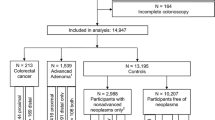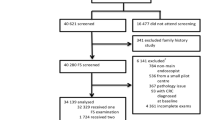Abstract
Background
Flexible sigmoidoscopy as the preferred initial investigation for patients with low-risk colorectal symptoms requires formal evaluation.
Methods
From August 1999 to July 2001, 323 patients (166 men) attended the one-stop colorectal clinic. All the patients were examined using a 60-cm flexible sigmoidoscope. Presenting symptoms and findings were reviewed.
Results
The mean age of the study patients was 38.6 ± 11.87 years, with the majority (89.1%) younger than 50 years. Rectal bleeding was the most common problem (86.6%), followed by bowel habit change (13.7%). For 65.6% of the patients, a view to the proximal sigmoid was obtained. The main reason for incomplete assessment was poor bowel preparation (67.5%). The most common finding, in 202 patients (64%), was haemorrhoids. Polyps were found in 9.9% of the patients, whereas four patients (1.2%) with cancer were identified. Overall, 269 patients (83.4%) required no further investigation.
Conclusion
Flexible sigmoidoscopy is an effective method for assessing low-risk patients.
Similar content being viewed by others
References
Chapuis PH, Goulston KJ, Dent OF, Tait AD (1985) Predictive value of rectal bleeding in screening for rectal and sigmoid polyps. Br Med J 290: 1546–1548
Jones LS, Nicholson RW, Evans DA (2001) Experience with a one-stop colorectal clinic. J R Coll Surg Edinb 46: 96–97
Kee F, Wilson RH, Gilliland R, Sloan JM, Rowlands BJ, Moorehead RJ (1992) Changing site distribution of colorectal cancer. Br Med J 305: 158
Maule WF (1994) Screening for colorectal cancer by nurse endoscopists. N Engl J Med 330: 183–187
McCallion K, Mitchell RM, Wilson RH, Kee F, Watson RG, Collins JS, Gardiner KR (2001) Flexible sigmoidoscopy and the changing distribution of colorectal cancer: implications for screening. Gut 48: 522–525
McCallum RW, Meyer CT, Marignani P, Cane E, Contino C (1984) Flexible sigmoidoscopy: diagnostic yield in 1,015 patients. Am J Gastroenterol 79: 433–437
Niv Y, Asaf V (1992) Open-access, flexible, fibreoptic sigmoidoscopy in a regional primary care clinic. J Clin Gastroenterol 15: 218–221
Toomey P, Asimakopoulos G, Zbar A, Kmiot W (1998) “One-stop” rectal bleeding clinics without routine flexible sigmoidoscopy are unsafe. Ann R Coll Surg Engl 80: 131–133
Underwood D, Makar R, Najfi SM, Neilly PJD, Gilliland R (2002) Prospective randomised single blind trial of Fleet phosphate enema versus glycerin suppositories as preparation for flexible sigmoidoscopy. Colorect Dis 4: 15
Vellacott KD, Roe AM, Mortensen NJMcC (1987) An evaluation of a direct-access flexible fibreoptic sigmoidoscopy service. Ann R Coll Surg Engl 69: 149–152
Author information
Authors and Affiliations
Corresponding author
Rights and permissions
About this article
Cite this article
Badger, S.A., Gilliland, R. & Neilly, P.J.D. The effectiveness of flexible sigmoidoscopy as the primary method for investigating colorectal symptoms in low-risk patients. Surg Endosc 19, 1349–1352 (2005). https://doi.org/10.1007/s00464-004-2215-2
Received:
Accepted:
Published:
Issue Date:
DOI: https://doi.org/10.1007/s00464-004-2215-2




